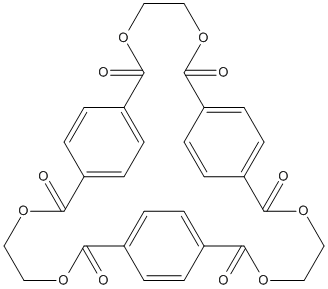Cyclo-tris-ethylene-terephthalate
General
Type : Polymer || Polyester || Terephthalate || Aromatic polyester
Chemical_Nomenclature : 3,6,13,16,23,26-hexaoxatetracyclo[26.2.2.28,11.218,21]hexatriaconta-1(31),8,10,18(34),19,21(33),28(32),29,35-nonaene-2,7,12,17,22,27-hexone
Canonical SMILES : C1COC(=O)C2=CC=C(C=C2)C(=O)OCCOC(=O)C3=CC=C(C=C3)C(=O)OCCOC(=O)C4=CC=C(C=C4)C(=O)O1
InChI : InChI=1S\/C30H24O12\/c31-25-19-1-2-20(4-3-19)26(32)38-15-16-40-28(34)22-9-11-24(12-10-22)30(36)42-18-17-41-29(35)23-7-5-21(6-8-23)27(33)39-14-13-37-25\/h1-12H,13-18H2
InChIKey : IICRGUKQYYOPIG-UHFFFAOYSA-N
Other name(s) : cyclic PET trimer, cyclo-tris-ethylene terephthalate, Ethylene Terephthalate Cyclic Trimer, SCHEMBL3874923, DTXSID801017127, AS-62535, CTR

Target
Families : Cutinase, Polyesterase-lipase-cutinase
References (3)
| Title : Enzymes for the biofunctionalization of poly(ethylene terephthalate) - Zimmermann_2011_Adv.Biochem.Eng.Biotechnol_125_97 |
| Author(s) : Zimmermann W , Billig S |
| Ref : Adv Biochem Eng Biotechnol , 125 :97 , 2011 |
| Abstract : Zimmermann_2011_Adv.Biochem.Eng.Biotechnol_125_97 |
| ESTHER : Zimmermann_2011_Adv.Biochem.Eng.Biotechnol_125_97 |
| PubMedSearch : Zimmermann_2011_Adv.Biochem.Eng.Biotechnol_125_97 |
| PubMedID: 21076908 |
| Title : A heterogeneous kinetic model for the cutinase-catalyzed hydrolysis of cyclo-tris-ethylene terephthalate - Figueroa_2006_Biotechnol.Prog_22_1209 |
| Author(s) : Figueroa Y , Hinks D , Montero G |
| Ref : Biotechnol Prog , 22 :1209 , 2006 |
| Abstract : Figueroa_2006_Biotechnol.Prog_22_1209 |
| ESTHER : Figueroa_2006_Biotechnol.Prog_22_1209 |
| PubMedSearch : Figueroa_2006_Biotechnol.Prog_22_1209 |
| PubMedID: 16889400 |
| Title : Enzyme-catalyzed hydrolysis of poly(ethylene terephthalate) cyclic trimer - Hooker_2003_J.Appl.Polym.Sci_89_2545 |
| Author(s) : Hooker J , Hinks D , Montero G , Icherenska M |
| Ref : J Appl Polym Sci , 89 :2545 , 2003 |
| Abstract : Hooker_2003_J.Appl.Polym.Sci_89_2545 |
| ESTHER : Hooker_2003_J.Appl.Polym.Sci_89_2545 |
| PubMedSearch : Hooker_2003_J.Appl.Polym.Sci_89_2545 |
| PubMedID: |